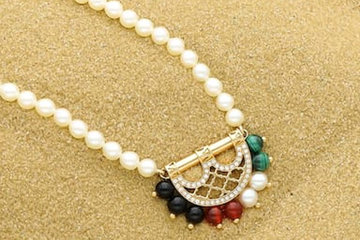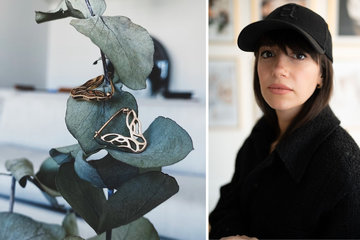
Certified Image Consultant and celebrity stylist Rana Saab helps sort out our jewellery-based conundrums. We asked the Lebanese Founder of Dubai-based Mirror Image Consulting the essentials while she was conducting workshops about face and body mapping techniques and choosing jewellery that complements one’s looks.
How do you conduct face and body mapping techniques? Do you study one’s face and figure? Are any smart tools involved?
The face and body mapping are done by visual assessments and technical measurements, which include measuring the horizontal and vertical proportions in addition to any unique prominent features.

Rana Saab
Can you give us some tips on what type of jewellery is most suitable for different body types and face shapes?
As a general rule, we aim to create balance and harmony when selecting jewellery to match our face shapes and unique body shapes and scales. For example, if you have a round face and large bone structure, you should stay away from circular designs and small or large-scale pieces. Go for longer earrings in chandelier styles to balance your face shape and add length/ slim features, while keeping the size of the earring medium.
Shapes to choose include vertical, teardrop, inverted triangle and diagonal lines. Any design with a round shape or silhouette such as flowers, stars or hoops will only add to the roundness of your face. Very small pieces tend to disappear on someone with a large bone structure while large ones only add to the volume.
Another consideration we take into account is neck length and thickness, so if for example you have a round face and short/thick neck then stay away from chokers and short necklaces that end at the base of your neck in a circular shape. Opt for long chains and pendants instead and create interest with layering different sizes and lengths of necklaces to create a pleasing V shape that visually extends the neck length and slims down your face.
Statement necklaces in medium size can be worn lower on the chest, not at the base of the neck. An opposite example would be someone with an oblong face and long, slim neck with medium scale. In this case the face is longer than wider and so the aim is to visually shorten the face and add volume at the cheekbone level with earrings. Best styles would include studs, round, wide and interesting geometric shapes that end above the jaw line and never extend down to the chin or below.
As for necklaces, go for chokers, round designs that end at the base of the neck, statement necklaces in medium to large scale and avoid long necklaces and chains.

Rana Saab poses with Eva Longoria
3. Do certain skin tones (yellow vs. pink) work better with certain colours? For example yellow gold looks great on dark skin tones while, while rose gold and white gold is more versatile (matches all skin tones).
The first thing we look for in colour analysis is the skin undertone (warm: yellow gold undertone versus cool: pink/blue silver undertone). The shade of the skin (light pale to deep tanned) is another factor. So, in that case, yellow gold only looks good on tanned skin that is warm in undertone. If you have a cool undertone and you are tanned or with a darker skin shade, then you should still go for silver/white gold.
The shade of the skin does not change its temperature (warm versus cool), it only allows us to play more with the intensity of the colour and its brightness. So to sum it up, those with warm skin tones look best in yellow gold, ranging from the copper/brassy tones to the lighter ones. If their skin has a soft shade, then rose gold looks great too. On the other hand, those with a cool undertone always look great in silver, and they can wear only the lighter shades of yellow gold (no brass or copper tint). Rose gold suits them as well if they have a soft colouring.
Colour analysis is done using professional draping, where we compare different undertones, shades and intensity of fabric material against the natural colouring of skin, eye and hair colour combinations.
You can refer to the website, www.ranasaab.com, for more examples on colour analysis draping.

















